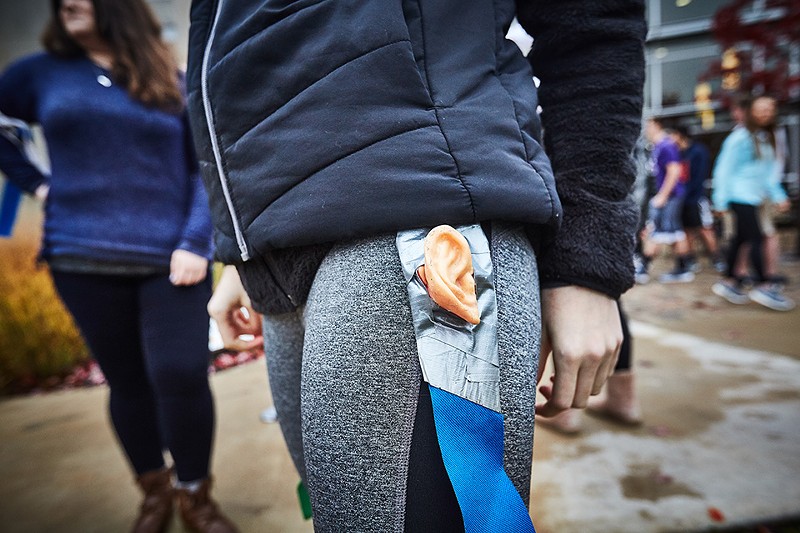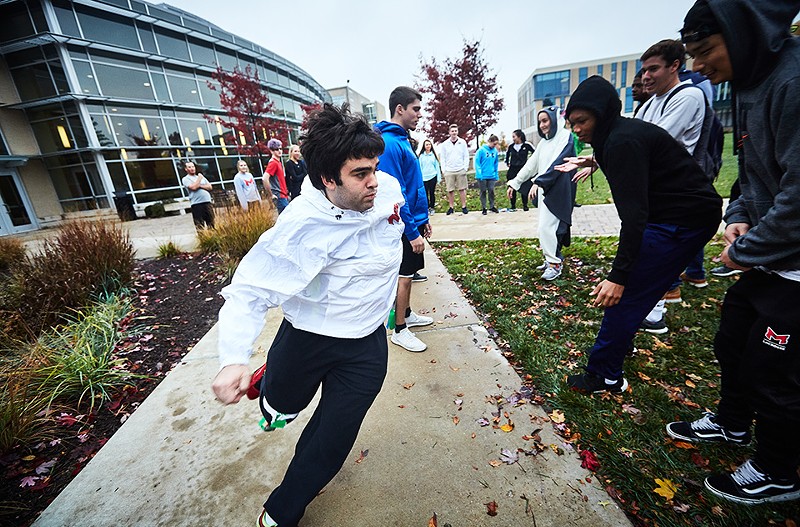The Herd
The students of HUM 297H gather in front of Reid Hall wearing mild looks of worry as they plop their backpacks onto red metal benches near a large swath of grass. It's Halloween — a gray, drizzly morning on campus — and they aren't sure what's in store.
The students are about halfway through the class, and they've already dealt with famine, disease and conflicting personalities both through reading and through unconventional real-life challenges. But today is even more unusual; today they have been told to meet outside. All Krakos and Marino suggested in recent days was to wear clothing that's easy to move around in. The students have obliged, arriving in hoodies, athletic pants and sneakers, but they can't help but wonder about ... well ... everything.
Krakos and Marino inspect a few mysterious bundles and chat quietly with each other before sending the students to the far end of the grass near Gander Hall. Krakos holds up a flag-football belt, one rubbery ear affixed to each of the two blue and green fabric strips flapping in the wind. "This is what you're trying to have survive," she says.
"Oh my God, nooooooo!" one girl shouts, understanding the game almost immediately.

Each person on a three- or four-member team — the same survival groups that the students have been in since a shake-up a few weeks ago — will wear belts with two ears as they hustle through a mass of zombie volunteers within a confined area. If the slow-moving zombies snatch an ear, it counts as a bite; the ears that make it to the other side will be added up as team points.
Over three rounds, the field becomes smaller, with the zombie population increasing to reflect the density of St. Louis, then New York City and finally Dubai. The question for the teams is whether they can make it through these "cities" with all members (and their ears) surviving, or whether they'll have to get creative and sacrifice friends for the good of the group — as characters have done on The Walking Dead.
"So where are my dead people?" Krakos asks. Students who had "died" during previous rolls of the mystery dice raise their hands. "Your ears don't count, but you do have to run through with them and they can count against you," Krakos tells them. "I know, I know. 'It's so unfair.'
"And where's the survivor with 'pneumonia'? Yeah, pneumonia left you with damaged lungs, so you can't run; you can only walk," Krakos continues as students grumble. "All of you, you can't hit the zombies. You can't hurt the zombies. You can't smack the zombies. You've just got to get through. Your entire grade is based on how many ears get to the other side."
Students look apprehensively at the small field, questioning whether they can dodge not only the volunteer zombies but also a few trees, a child-sized Disney tent and a wheeled plastic cart.
But the herd of zombies — made up of Zombie Class alumni as well as a psychology class -— is already starting to shuffle onto the grass. On Krakos' cue, they begin to groan hungrily.
Group one heads to the starting line and chats as Marino grins from the other end of the field. After Krakos gives the signal, the team of four jumps into the game area and tries to bolt around the hungry zombies. Ashley quickly loses both of her ears and "dies" as her teammates press ahead, somewhat stymied by the number of zombies within the narrow gauntlet.
Mady makes it through without being "bitten," while Reid and Madison each survive with one ear.
"I just tried to slip through as fast as I can and tried to push people with my shoulder so they couldn't grab my ears," Mady explains. "I guess it worked — I didn't lose any."
"I was just trying to go where people weren't," Reid adds.
The four other teams try their luck with varying degrees of success, with many teams running straight through or feigning to the side before zipping past the zombies the other way. With each attempt, the students think more carefully about strategy. One team forms an outward-facing circle and moves as a single unit. Another tries to ram the plastic cart through the zombie herd so that at least a few students have a chance at reaching safety.
After the professors condense the field to the smallest boundaries — about a twenty-foot square — a group even grabs the polyester tent, pulls it over their heads and tries to use it as a shield while running, only to collapse together when the zombies swarm.
"Every year, some group tries the tent thing, and it's always a cluster-disaster," Krakos whispers as students try to rebuild the smashed tent. "It always seems like a good idea to them, but you've got to think it through."
"We tried making a circle, we tried piggybacking," remembers Alison Riddle, a junior who took the class as a first-year and stopped by to watch the day's action. "The team that won my year had a kid in an electric wheelchair. Everybody hopped on and he put it on at full speed, and the zombies were worried about their toes, so they just got out of the way."
She adds, "I miss this a lot."
People are pushed. Boundaries are crossed. Risks are taken. Tents are broken. The final ear tally will have to wait until Krakos and Marino compare notes, but one thing is certain by day's end.
These students are survivors.







